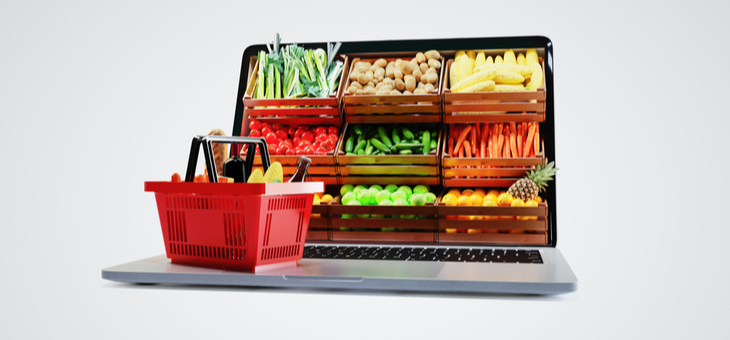The pandemic has pushed many Australians into changing the way they shop for groceries and, according to prominent retail analysts, that’s how it’s going to stay.
In fact, they say, all COVID-19 has done is accelerate the trend to online shopping.
Lockdowns have forced the hands of otherwise ‘click-shy’ shoppers. Australians are now buying twice as much food online every month than they did two years ago.
Now, for many of those who once feared browsing website catalogue columns instead of supermarket aisles, it’s expected to become their favourite way to shop.
Yes, the fad will become a mainstay, say retail experts.
“[COVID-19] changes consumer behaviour. The more entrenched these pandemics and the like become, the longer people have a chance to play with the technology out of need rather than out of desire, and learn about its benefits,” Retail Doctor Group chief Brian Walker told The New Daily.
“We are changing our shopping habits anyway, but COVID-19 has accelerated this to the point where online growth in these categories is anywhere between 20 and 40 per cent.
“What was single-digit growth in those areas pre-COVID is well and truly double-digit growth. It hasn’t changed the trend, but it has accelerated it dramatically.”
Read: Supermarkets announce major overhauls
The YourLifeChoices Life in a Post-Pandemic World Survey revealed that since the pandemic struck, 50 per cent of respondents felt more comfortable dealing with companies and service providers online. However, 11 per cent of those said it was ‘only because I’ve had to’.
Still, six in 10 said they would be more likely than before COVID-19 to keep using digital means to shop.
Online grocery shopping has boomed. The evidence is in the numbers. Woolworths and Coles enjoyed record e-commerce growth in the 2020-21 financial year and have already increased their online sales by 77.9 per cent and 61 per cent respectively this half-year.
And while Coles and Woolworths may enjoy a duopoly on the online grocery market, a new player has entered the field.
Geezy Go was launched in Sydney earlier this month and aims to compete with Woolworths and Coles.
The new digital grocery service is an online-only offering. It prepares orders in warehouses, charges a flat delivery fee of $3.99 and promises deliveries in under 20 minutes.
Read: Supermarkets start a price war and a new player takes aim at the giants
Geezy Go already has customers across 60 suburbs in Sydney, but Mr Walker says the independent, online-only supermarket has its work cut out for it trying to take business away from the two supermarket giants.
“Fifteen years ago, 85 cents in every dollar were spent at either a Coles or Woolworths business. Aldi has shown us there’s definitely room for new entrants … [so] it’s going to be interesting,” said Mr Walker.
“The challenge will be being price competitive, I think, because you need scale and range to do that. And to do that, you need demand, and to get demand you need to be price competitive, and so the circle continues.
“We are seeing everywhere in the world it is a game of scale and a game of buying power.”
Geezy Go plans to deliver across Melbourne and the rest of country by the end of the year.
“The traditional model is where the large supermarket chains have excelled, mainly people going into a store and spending time wandering the aisles,” a Geezy Go spokesman told The New Daily.
“We can digitise this whole experience, [and] what that allows for are the efficiencies that come with online shopping to be paired with our dark-store concept.”
Online grocery shopping is peaking across the globe. Worldwide Google searches for “food delivery” and “local food” reached all-time highs in April, says the BBC. In the UK alone, people were six times more likely to buy “veg boxes” than they were a year ago.
(Credit: Krystina Shveda/ Datawrapper Source: Google Trends)
In the US, the pandemic is pushing more consumers to buy essential products digitally, rapidly accelerating the development of online grocery, curbside pickup and same-day delivery.
So far, adoption of online grocery shopping in the US is around 17 per cent, but Insider Intelligence projects that as the pandemic runs its course, online grocery adoption will reach 55 per cent of US consumers by the end of 2024.
The pandemic has made us all re-examine how we get our groceries. It will also eventually change the way we shop instore – and the stores themselves.
Read: Aussie supermarkets named and shamed as junk food pushers
Local supermarkets will look very different in five years as retailers adjust to the adoption of post-pandemic online shopping.
Expect to see a “generational evolution in supermarket shopping”, says retail expert Professor Gary Mortimer.
“It’s back to the future,” said Prof. Mortimer.
“The modern supermarket we saw evolve over the ’80s, which was 4000 square metres and 15 aisles, will reverse back to almost a greengrocer.”
As much as 50 per cent of the retail space at your supermarket could be repurposed to service online shopping.
“Part of the space will become a mini fulfilment centre facilitating online delivery of dry groceries, and the other half [will] remain fresh produce, dairy and deli,” said Prof. Mortimer.
Have you switched to grocery shopping online? If not, why not? What would it take to get you to shop online? Or would you prefer to shop instore? Why not share your thoughts in the comments section below?
If you enjoy our content, don’t keep it to yourself. Share our free eNews with your friends and encourage them to sign up.

